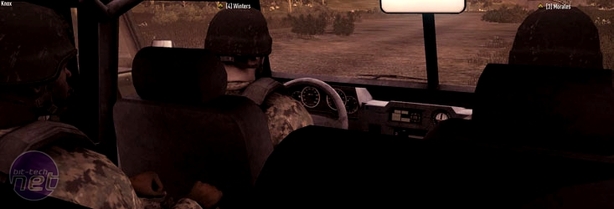
Dragon Rose
To be completely fair, it’s obvious that Dragon Rising isn’t entirely interested in appealing to the hardest of the hardcore mil-sim fans, unlike ArmA II. Simply the fact that Codemasters is also releasing it on consoles is proof enough of that because, while a Xbox 360 or PlayStation 3 might be good for a lot of things, they’ll never be suitable for a full-on mil-sim.So, there are compromises and parts of Dragon Rising have been reined in before they could bolt for true realism, while others have been allowed to make the dash for unrestrained freedom. Thus, we have a ballistics system which takes range and bullet-drop into account so that you have to gauge above your target, but no wind simulation.
Likewise, you can be instantly killed by a hit to the head, but most of the time a headshot will only leave your accuracy crippled and your vital fluids dribbling out until you apply a field dressing.
Granted, the veteran mil-sim fans are going to be disappointed at these compromises and there’ll likely be all sorts of accusations thrown around about how Codemasters can’t live up to the successes of the original Flashpoint developer, Bohemia. On the other hand though, the reality of the situation is that the hardcore mil-sim audience is actually quite small and most players (like, say, everyone here except for Antony and James) will want a touch of forgiveness built into the game. If nothing else it helps compensate for the fact that you lose all the important olfactory senses that’d help you out if it were a real battle.
The problems come though where Codemasters has tried to reconcile the need for compromise with the unforgiving nature of the genre, resulting in a game that isn’t truly as difficult as some of its peers but suffers from a lack of a tutorial system. There’s no basic training whatsoever, only a series of uninformative prompts that pop up in the first mission with advice like ‘Press the Map button to bring up the Map and set orders for your squad’. Pretty bland stuff, immediately funnelling you back into the keyboard settings to find ‘the Map button’ and ensuring plenty of tinkering as you figure out the nuances.
The map isn’t even any good either, showing up fuzzy and poorly detailed when you try to get a zoomed in look. It’s a challenge just to even work out where some good tree cover is.
The intricacies of ordering your squad around in singleplayer are almost insurmountable too, with a four-way radial menu that was blatantly designed with console audiences being the only option. It’s so layered with decision trees that in the time it takes you to go through a chain like ‘Tactics > Formation > Roe’, ‘Unit 3 > Assault > The Building’, ‘Unit 4 > Enter the vehicle’, ‘Unit 2 > Suppressing fire’ then you could have done it all yourself.
Well, you could if you’d master the weapons anyway. Since there’s little introduction given to the guns, how to use them and what forces they are affected by it’ll take you a few lives before you learn how to calculate the bullet drop for a single weapon. The issue then gets complicated by the fact that there’s so many weapons too, as well as vehicles.
One of the truly damning things about Operation
The boats aren’t much better either, rocking like Elvis's grandfather in a rocking chair. Helicopters on the other hand are easy enough to control once you’ve retreated to the keyboard menu a few more times to check the controls, but are generally just pretty joyless to use. Despite the spinning rotors and mounted weaponry, the 'copters feel as lackadaisical as a manic-depressive sloth, with zero sensation of speed being fed back to the player.

MSI MPG Velox 100R Chassis Review
October 14 2021 | 15:04











Want to comment? Please log in.